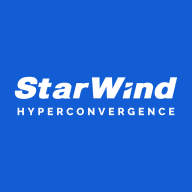

StarWind Virtual SAN and Azure Stack HCI are leading contenders in the hyper-converged infrastructure domain. StarWind holds an advantage in pricing and flexibility, while Azure Stack HCI excels in integration with Microsoft services and features.
Features: StarWind Virtual SAN delivers flexible storage options that integrate well with existing IT infrastructures. Its ability to provide scalable and customizable solutions makes it appealing for efficient resource use. Azure Stack HCI stands out for its seamless Azure service integration, enabling organizations to leverage advanced cloud capabilities. It offers a robust and comprehensive solution for businesses within the Microsoft ecosystem.
Room for Improvement: StarWind needs enhancements in its management interface, deeper cloud integration, and more robust automation capabilities to compete effectively. Azure Stack HCI could improve by simplifying deployment, reducing costs, and broadening hardware compatibility to attract a wider range of users.
Ease of Deployment and Customer Service: StarWind Virtual SAN is known for easy deployment and excellent support, offering a straightforward setup process ideal for businesses seeking quick implementation. Azure Stack HCI, while providing a broader service spectrum, requires a more complex setup, supported by thorough documentation and community resources.
Pricing and ROI: StarWind Virtual SAN is recognized for its cost-effective pricing model and rapid ROI, making it attractive for budget-focused organizations. Azure Stack HCI, though requiring higher initial investment, promises extensive value through its feature-rich offerings and Azure integration, appealing in the long run for strategic benefits.
There has been some return on investment in terms of just time usability and reduction of footprint.
We don't sell a lot of redundant servers, so it's not a massive ROI, but the ability to rely on their technical support and the software's ease of setup allows us to reduce labor costs and go to market competitively.
When we set it up, they validate our settings and configurations to ensure we don't miss anything.
I believe that scalability should be further improved, especially considering the possibility that environments may grow exponentially.
Hyper V seems to lag behind compared to VMware.
A more intuitive interface or an improved dashboard for monitoring the cluster would also be helpful, as it would facilitate performance tracking and help identify potential issues before they affect services.
Having more visibility on what's actually happening when an error occurs would be beneficial.
The licensing is quite expensive because it's per call.
The integration with Azure using Azure Arc is excellent.
StarWind Virtual SAN helps us keep customer satisfaction and provides the solutions we need without having to hire many IT specialists.
Thanks to its seamless integration with Proxmox, the implementation of high availability servers has drastically reduced downtime, which is crucial for our security-focused company.


Azure Stack HCI efficiently integrates software-defined networking and Azure Kubernetes Service, offering a streamlined hybrid setup for VM management while maintaining top performance.
Azure Stack HCI enhances data center operations with high-end processors and storage, optimal Kubernetes support, and integration with Azure Arc and Azure Site Recovery. High application density in four-node configurations improves both time and infrastructure efficiency. Despite its strengths, the platform can improve in areas like software-defined networking, operational management, and simplifying deployments, which currently rely on PowerShell. Users often desire better training and integration with Microsoft Azure Portal, along with multi-cluster capabilities and storage architecture enhancements. Improvements in Hyper V virtualization are also needed to match competitors like VMware.
What are the key features of Azure Stack HCI?In sectors like government, Azure Stack HCI is crucial for running secure on-premise services with selectable Azure features to ensure data privacy. Businesses leverage the platform for VM creation, management, and monitoring through Windows Center, alongside Kubernetes production environments. Connectivity with Azure allows for smoother cloud transitions, appreciated for its dashboard manageability and substantial network capacity.
StarWind Virtual SAN provides high availability and fault tolerance for virtualized environments without the need for dedicated SAN hardware. It allows for real-time replication between servers, shared storage for Hyper-V clusters, and enables vMotion and High Availability features for VMware vSphere. The solution reduces costs and leverages existing hardware while providing a scalable and reliable infrastructure. Valuable features include ease of use, scalability, top-tier support, hardware agnosticism, and the ability to use off-the-shelf standard servers to increase storage space. StarWind VSAN has helped organizations improve performance, data availability, and data security while reducing downtime and providing cost-saving storage options.
We monitor all HCI reviews to prevent fraudulent reviews and keep review quality high. We do not post reviews by company employees or direct competitors. We validate each review for authenticity via cross-reference with LinkedIn, and personal follow-up with the reviewer when necessary.